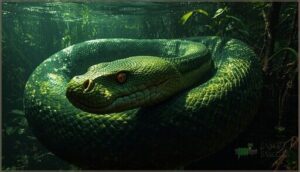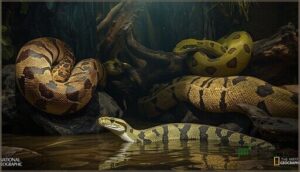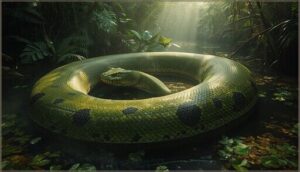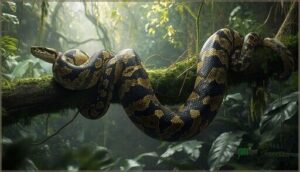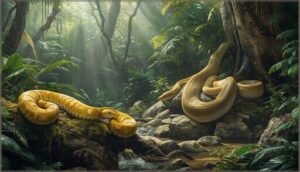This site is supported by our readers. We may earn a commission, at no cost to you, if you purchase through links.
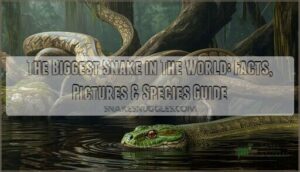
When a 26-foot reticulated python was discovered in Malaysia, it took eight men to lift it—and even then, the snake’s muscles rippled with enough power to crush bones in seconds. You might assume one species holds the undisputed title of “biggest snake in the world,” but the answer depends on whether you’re measuring length or weight. The green anaconda dominates the scales at up to 500 pounds, while the reticulated python stretches longer than a telephone pole, and their extinct cousin Titanoboa dwarfed them both at nearly 50 feet.
These leading predators possess jaw-dropping adaptations—elastic ligaments that let them swallow prey three times wider than their heads, heat-sensing pits that detect warm-blooded targets in total darkness, and muscular coils generating forces that would rival a car’s hydraulic press.
Understanding these giants means examining verified records, comparing species across continents, and appreciating why protecting them matters for ecosystems from the Amazon to Southeast Asia.
Table Of Contents
- Key Takeaways
- The Largest Snake Species in The World
- Green Anaconda: The Heaviest Snake
- Reticulated Python: The Longest Snake
- Other Impressive Giant Snake Species
- Conservation, Threats, and Human Interaction
- Frequently Asked Questions (FAQs)
- What is the largest snake in the world?
- What is the heaviest snake on Earth?
- What are the big snakes found on Earth?
- What is the largest snake in Africa?
- Which Python is the longest living snake?
- What is the largest snake in Australia?
- Was the 26 foot snake found?
- How long can the reticulated python grow?
- What is the average length of the king cobra?
- Where is the yellow sea snake found?
- Conclusion
Key Takeaways
- The title of “world’s largest snake” splits between two species: green anacondas reign as the heaviest at up to 550 pounds, while reticulated pythons claim the longest measurement at verified lengths exceeding 30 feet—each dominating a different dimension of size.
- These giant constrictors possess remarkable adaptations, including elastic jaw ligaments that allow them to swallow prey three times wider than their heads, heat-sensing pits for detecting warm-blooded targets in complete darkness, and muscular coils generating bone-crushing pressure.
- Conservation threats, including habitat loss, illegal wildlife trade worth $10 billion annually, and fear-driven killings, have reduced some giant snake populations to just 5% of their original range, making protection efforts critical for maintaining ecosystem balance.
- Giant snakes serve as essential apex predators that control prey populations and maintain healthy ecosystems, yet human-snake encounters—resulting in approximately 2.5 million bites annually worldwide—often stem from cultural misunderstandings rather than actual aggression from these largely misunderstood creatures.
The Largest Snake Species in The World
When you think about the world’s largest snakes, you’re probably picturing something truly massive—and you’d be right. These giants can stretch longer than a school bus and weigh as much as a grand piano, with physical adaptations that make them formidable predators in their environments.
Let’s look at the record holders, their unique features, and some notable individual snakes that have made headlines.
Record-Holding Snake Species by Length and Weight
The reticulated python holds the title as the longest snake, with verified maxima reaching 10 meters. However, the green anaconda claims the heaviest snake crown, weighing up to 227 kilograms. Fossil records reveal that Titanoboa, extinct for millions of years, dwarfed both species at 12–15 meters long and 1,135 kilograms.
These comparative physique differences illustrate how largest snake species vary dramatically in dimension. Some snakes, like the African Rock Pythons, can reach up to 7 meters in length.
Key Physical Characteristics and Adaptations
Understanding snake size requires looking beyond length alone—you’ll notice muscular constriction power, jaw flexibility enabling whole-prey ingestion, and scale hydrodynamics that reduce water drag. Heat sensing pits detect warm-blooded targets in darkness, while defensive postures protect key organs during threats.
These snake physical attributes and adaptations reveal how anatomy shapes survival, from camouflage patterns mediating thermoregulation to elastic ligaments accommodating meals larger than their heads.
Green anacondas, for example, thrive in tropical rainforest habitats across northern South America.
Notable Individual Giant Snakes (With Pictures)
While anatomy reveals capability, individual snakes bring these adaptations to life. You’ll encounter impressive specimens documented through careful measurement and photography:
- Medusa, a Reticulated Python, held the captive record at 25 feet 2 inches and 350 pounds in Kansas City
- Ana Julia, a 20.7-foot Green Anaconda, became Brazil’s most famous serpent before her 2024 death
- Malaysian Reticulated Python reached 26 feet, showcasing exceptional Python Pattern Uniqueness
- Burmese Python individuals documented at 23 feet demonstrate impressive Asian giant snake populations
- African Rock Python specimens exceeding 16 feet reveal sub-Saharan biodiversity
These Famous Snake Personalities illustrate Anaconda Size Variations and Record Snake Lengths, generating significant Media Snake Coverage while advancing scientific understanding of maximum growth potential across species.
Green Anaconda: The Heaviest Snake
When you think of the world’s biggest snake, the green anaconda deserves the spotlight. While it may not stretch quite as long as the reticulated python, this South American giant claims the title of heaviest snake on Earth, with females reaching truly staggering weights.
Let’s explore what makes this water-loving constrictor such a fascinating creature.
Maximum Size and Weight Achieved
You might wonder how massive a green anaconda can truly grow. Verified records show a maximum length of 8.43 meters (27.7 feet) and a maximum weight of around 227 kilograms (500 pounds), though some remarkable individuals may exceed these figures. Size dimorphism plays an important role—females dwarf males considerably.
| Measurement | Female Average | Verified Maximum |
|---|---|---|
| Snake length | 4.6 meters (15 ft) | 8.43 meters (27.7 ft) |
| Snake weight | 70 kg (154 lbs) | 227 kg (500 lbs) |
| Body diameter | 25 cm (10 inches) | 30+ cm (12+ inches) |
Weight variation depends heavily on anaconda growth patterns, recent feeding, and pregnancy status. Historical records mention specimens exceeding 300 kilograms, but measurement accuracy remains challenging with living giants.
Natural Habitat and Geographic Distribution
Across the tropical lowlands of South America, green anacondas inhabit swamps, marshes, and slow-moving rivers throughout the Amazon and Orinoco basins. Their native range spans Brazil, Venezuela, Colombia, Ecuador, Peru, and several other countries—an estimated 623,511 square kilometers of diverse ecosystems.
During seasonal migration, they seek permanent water or bury themselves in mud when dry conditions arrive. Small introduced populations exist in Florida, though no established breeding groups are confirmed.
Feeding Habits and Hunting Techniques
With lightning precision, green anacondas lie submerged in murky waters, waiting to ambush prey along riverbanks. Their constriction methods overwhelm victims within seconds—backward-curving teeth grip while powerful coils squeeze, collapsing circulation and preventing breathing.
These ambush predators consume fish, caimans, capybaras, and even jaguars up to 50% of their body mass. After large meals, their feeding frequency drops dramatically—they can fast for months due to slow digestion.
Fascinating Facts and Visual Gallery
Did you know green anacondas have eyes and nostrils on top of their heads, letting them stay hidden underwater while watching for prey? Their olive-green bodies with dark oval spots create perfect camouflage in swamps.
These largest snake species showcase extreme snake size and characteristics—females reach 30 feet and 550 pounds, with unique snake traits like protective coiling when threatened. Their snake physical attributes reveal prehistoric snake giants’ evolutionary legacy.
Reticulated Python: The Longest Snake
The reticulated python holds the record as the world’s longest snake, with verified individuals reaching over 30 feet in length.
You’ll find these impressive serpents throughout Southeast Asia, where they’ve adapted to diverse environments from rainforests to suburban areas.
Their distinctive diamond-patterned scales, massive size, and complex relationship with humans make them one of the most fascinating giant snakes on Earth.
Verified Length Records and Growth Potential
You might wonder how scientists measure a 25-foot snake accurately. The longest verified reticulated python stretched 32 feet 9.5 inches, discovered in Sulawesi, Indonesia, in 1912. Captive lengths tell a different story, with proper documentation revealing impressive growth factors:
- Medusa holds the captive record at 25 feet 2 inches, weighing 350 pounds
- Wild specimens generally reach 20-21 feet maximum length
- Measurement accuracy requires anesthesia, as historical claims often exaggerate size due to stretched skins
Growth rates depend on food availability and environmental conditions.
Habitat Range and Environmental Preferences
You’ll find reticulated pythons thriving across Southeast Asia’s tropical rainforests, from Indonesia and the Philippines to Myanmar and southern China. These adaptable giants inhabit elevations up to 4,300 feet, favoring humid forests near rivers and streams.
Their aquatic adaptations allow them to swim between islands, though habitat loss from deforestation increasingly threatens their range. Climate impact and conservation efforts now determine their survival across these diverse snake habitats and environments.
Diet, Behavior, and Notable Incidents
Reticulated pythons showcase impressive feeding habits, swallowing prey up to one-quarter their length—including mammals, birds, and reptiles near human settlements. Their python behavior includes ambush tactics and constriction to suffocate victims before consuming them whole.
While snake attacks on humans remain rare, documented incidents include fatal encounters in Southeast Asia, highlighting the ecological impact and power of these largest snakes in the world.
Striking Images and Unique Patterns
Beyond their hunting prowess, you’ll notice the reticulated python’s striking snake coloration—a netlike pattern of diamond-shaped blotches in yellow, black, and brown that provides superb pattern camouflage in forest leaf litter.
This pattern complexity varies individually, while genetic morphs like “Tiger” and “Ivory” showcase striking captive patterns.
The evolutionary significance of these snake characteristics lies in predator avoidance and effective snake identification across their Southeast Asian range.
Other Impressive Giant Snake Species
While the green anaconda and reticulated python steal the spotlight, they’re not the only giants worth your attention.
Several other massive snake species command respect through their impressive dimensions and unique adaptations. Let’s look at three more heavy-hitters that deserve a place in any discussion about the world’s largest snakes.
Burmese Python Size and Distribution
With an impressive size reaching up to 5.79 meters in Florida, the Burmese Python ranks among the world’s most formidable constrictors. You’ll encounter this Southeast Asia native across diverse landscapes, from rainforests to wetlands, though its invasive Florida range now presents significant population impact data worth understanding.
Key Physical Size Traits and Distribution:
- Native Habitat Span – Ranges from India through Southeast Asia, inhabiting grasslands, marshes, and river valleys up to 2,800 meters elevation
- Typical Measurements – Adults average 3 to 5 meters (10 to 16 feet), with females substantially bulkier than males
- Record Dimensions – Captive individuals exceed 182 kg (403 pounds), while wild Florida specimens reached verified lengths of 19 feet
- Dwarf Python Forms – Island populations in Java and Sulawesi average just 2 to 2.5 meters, demonstrating geographic variation
- Invasive Florida Range – Established populations dominate Everglades ecosystems from Lake Okeechobee southward, with thousands documented through removal programs
African Rock Python Physical Features
While Burmese pythons dominate headlines, the African Rock Python commands equal respect through its impressive physical features. You’ll recognize this heavyweight by its muscular build, reaching body mass over 90 kg with sturdy construction.
Scale patterns display distinctive dark blotches across yellowish-gray skin, while heat pits near the lips detect warm-blooded prey in darkness—color variation depends on geographic location.
Amethystine Python Characteristics
Moving eastward, the Amethystine Python earns its name through stunning scale iridescence—blue-purple hues shimmer under sunlight across olive-brown skin. You’ll find this nocturnal hunter in northern Australia and Papua New Guinea, where heat detection pits and jaw flexibility enable it to consume prey whole.
Notable characteristics include:
- Hatchling size reaches 24-26 inches at birth
- Adults average 10-12 feet with remarkable specimens exceeding 28 feet
- Vertical pupils improve nocturnal vision capabilities
- Heat-sensing organs detect warm-blooded prey in darkness
Comparative Photo Gallery of Large Snakes
Visual comparisons reveal striking differences among giants. Size comparison visuals place these species side-by-side, showcasing pattern variation and habitat preferences that aid record-holder identification.
| Snake Species | Maximum Length / Weight |
|---|---|
| Green Anaconda | 30 ft / 550 lbs |
| Reticulated Python | 32 ft / 350 lbs |
| Burmese Python | 23 ft / 200+ lbs |
| African Rock Python | 24 ft / 225 lbs |
Extinct snake reconstructions, like Titanoboa’s 42.7-foot frame, provide evolutionary context you won’t find elsewhere.
Conservation, Threats, and Human Interaction
The world’s largest snakes face pressures you mightn’t expect—from shrinking habitats to illegal hunting and even cultural misunderstandings. When humans and giant snakes cross paths, the outcomes depend heavily on awareness and respect for these fascinating creatures.
Let’s examine the conservation status of these species, the real threats they’re up against, and why protecting them matters more than you might think.
Conservation Status of The Largest Snakes
You might be surprised to learn that conservation efforts for giant snakes vary dramatically by species. The reticulated python holds “Least Concern” status, while the green anaconda remains “Not Evaluated” globally.
CITES regulations monitor international trade, but habitat loss and illegal hunting continue threatening snake populations.
Public perception often complicates conservation, as fear drives retaliatory killings despite these impressive creatures’ ecological importance.
Threats Facing Giant Snake Populations
Across continents, giant snake populations face mounting pressures from Habitat Loss, Illegal Trade, and Climate Change. You’ll find these impressive creatures threatened by wetland drainage, deforestation, and a $10 billion wildlife trafficking industry.
Human Conflict drives fear-based killings, while Invasive Species like Burmese pythons disrupt ecosystems.
Conservation efforts struggle against exotic pet trade demand, fragmented habitats, and shifting geographic ranges that intensify snake threats to already vulnerable populations.
Human-Snake Encounters and Cultural Impact
You might be surprised to learn that globally, approximately 2.5 million snakebites occur annually, resulting in around 80,000 deaths, primarily affecting rural farmers in Asia and Africa. Cultural perceptions blend fear with fascination—snakes serve as cultural icons representing transformation and wisdom across mythologies.
Urban encounters peak during rainy seasons, while mitigation strategies through education help reduce unnecessary killings. The exotic pet trade further complicates snakes and human interaction, intensifying conservation challenges.
Importance of Protecting Giant Snakes (With Photos)
Giant snakes aren’t just impressive—they’re essential for ecosystem balance, controlling prey populations and maintaining healthy ecosystems. Conservation efforts are critical as habitat loss threatens these species, with some retaining only 5% of their original range.
Giant snakes are essential for ecosystem balance, yet habitat loss threatens some species down to just 5% of their original range
Public education reduces fear-driven killings, while visual documentation aids scientific monitoring and awareness. Protecting them aids snake conservation and preserves ecological balance for countless interconnected species.
Frequently Asked Questions (FAQs)
What is the largest snake in the world?
The world’s largest snake depends on your measurement—the green anaconda reigns as the heaviest at 550 pounds, while the reticulated python stretches longest at 30 feet, defying simple comparisons.
What is the heaviest snake on Earth?
The green anaconda holds the title as the heaviest snake, with verified specimens weighing up to 215 pounds and some unverified reports claiming weights exceeding 550 pounds in South America’s wetlands.
What are the big snakes found on Earth?
You’ll encounter several impressive biggest snakes across continents: the Green Anaconda dominates South America’s wetlands, while Reticulated Pythons and Burmese Pythons inhabit Southeast Asian forests, alongside Africa’s rock pythons and Australia’s amethystine species.
What is the largest snake in Africa?
The African rock python holds the title as Africa’s largest snake species, with the Central African rock python subspecies reaching impressive lengths up to 20 feet and weighing over 200 pounds.
Which Python is the longest living snake?
The longest living snake species among pythons is the Reticulated Python, documented at 32 years in captivity.
Wild longevity averages just 23 years due to dietary influence, environmental impact, and predation challenges affecting growth patterns.
What is the largest snake in Australia?
You’ll find Australia’s largest snake in the tropical rainforests of Queensland—the scrub python.
This impressive constrictor reaches 28 feet, adapting to diverse snake habitats and behavior while rarely posing threats during human encounters.
Was the 26 foot snake found?
Yes, a 26-foot Northern Green Anaconda named Ana Julia was discovered in Brazil’s Amazon in February Scientists verified the measurement during documentation, making it among the longest anacondas recorded.
Sadly, it was later found dead.
How long can the reticulated python grow?
Reticulated pythons (Malayopython reticulatus) commonly reach 20 feet, with mainland females growing longest. Maximum length records approach 26 to 30 feet, though captive growth and island dwarfs show significant variation based on prey availability and environmental factors.
What is the average length of the king cobra?
King cobra (Ophiophagus hannah), the longest venomous snake, usually measures 10 to 13 feet. Sexual dimorphism shows males averaging slightly larger.
Regional size variation exists across populations, with maximum length records reaching approximately 19 feet.
Where is the yellow sea snake found?
The yellow-bellied sea snake inhabits tropical and subtropical ocean waters across the Indo-Pacific region, from Africa’s eastern coast through southern Asia and the Pacific to Central and South America’s western shores.
Conclusion
These serpents move through the world like living rivers, their scales catching light as they reshape our understanding of size and strength in nature.
Whether you’re captivated by the anaconda’s crushing weight or the reticulated python’s record-breaking length, exploring the biggest snake in the world with facts and pictures reveals creatures that deserve respect, not fear.
Your awareness helps protect these impressive giants for generations who’ll marvel at their power and grace.
- https://animaldiversity.org/accounts/Python_reticulatus/
- https://en.wikipedia.org/wiki/index.html?curid=1725661
- https://www.ultimatekilimanjaro.com/10-biggest-snakes-in-the-world/
- https://www.livescience.com/animals/snakes/50-foot-king-of-the-serpents-may-have-been-the-biggest-snake-to-ever-live
- https://www.nhm.ac.uk/our-science/departments-and-staff/staff-directory/patrick-campbell.html


